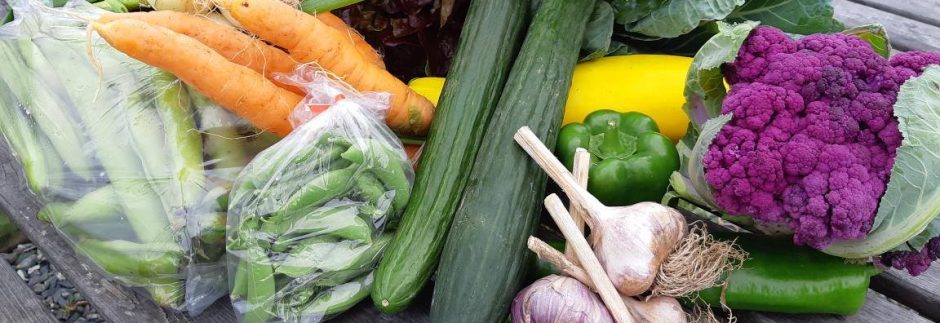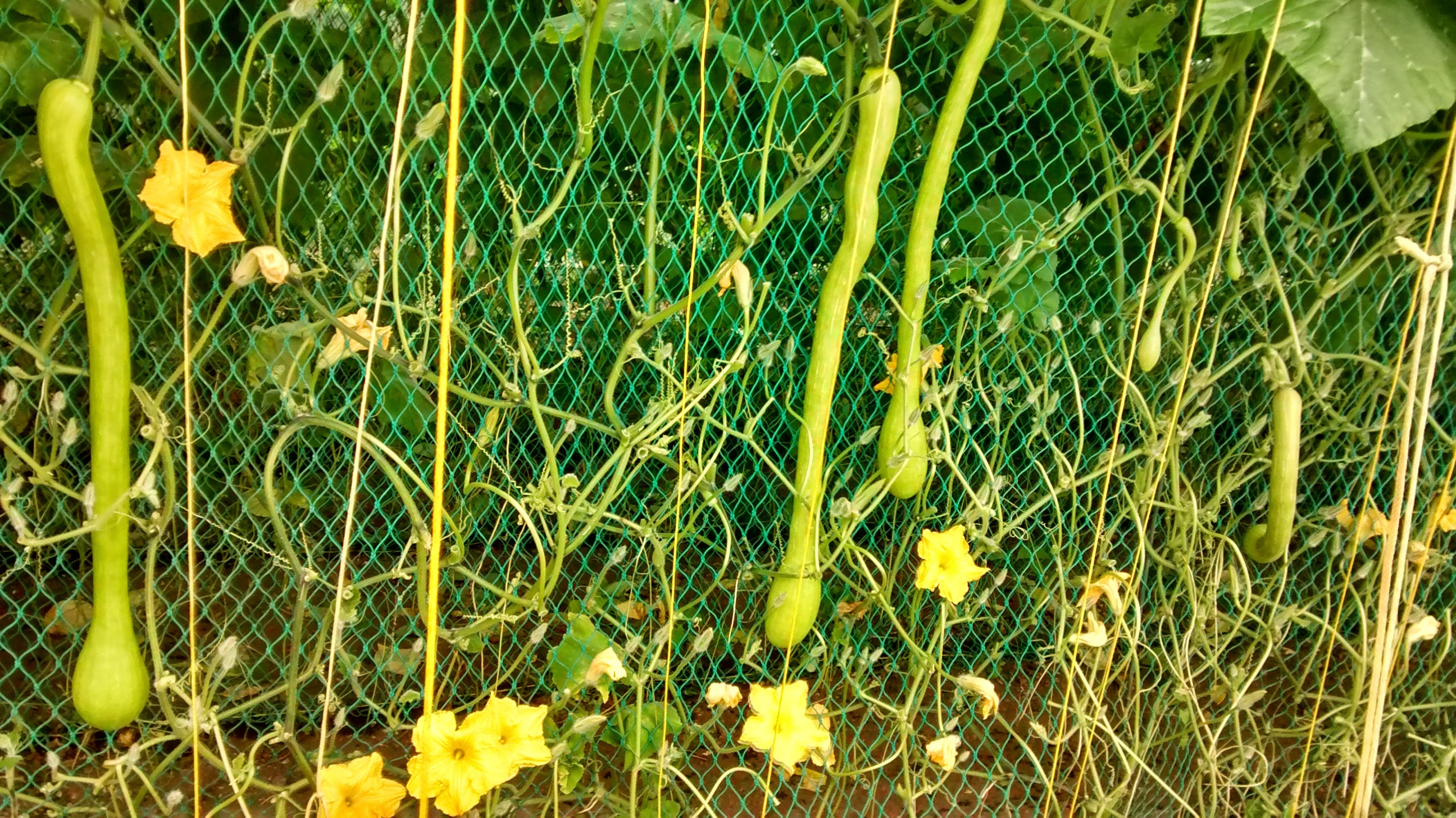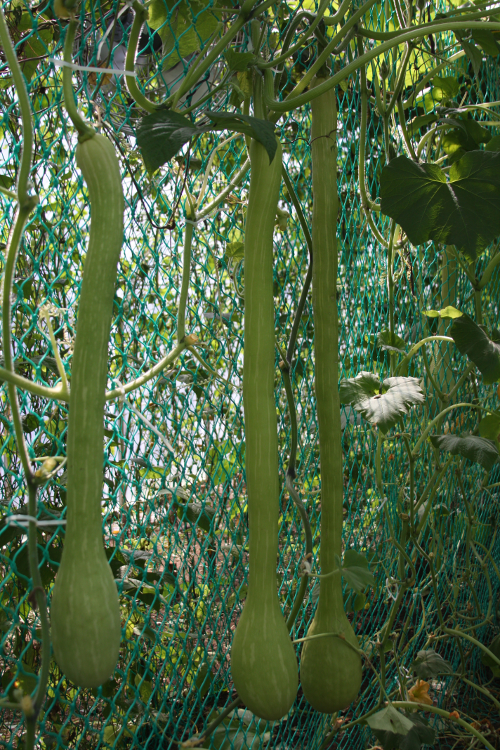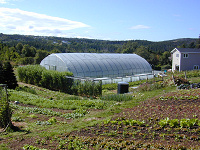Tromboncini have very pale green skin, sometimes almost pale yellow or tan, sometimes so light they look almost white. They tend to have varied faint white stripes like some zucchini varieties as well. When green and young, it cooks up sweeter than a zucchini; later in the season, when it’s golden and mature, it tastes more like a butternut squash.
The really nice thing about this variety is that all the seeds form in the bulbous part at the end, the way seeds all collect in the center of hard squash. That means you’ve got this whole long length of fruit with no seeds.
It’s drier and firmer than zucchini, though the pores near the skin do weep when you cut it, but I imagine if you wanted to make something akin to Tromboncino Parmesan or Fried Zucchini (dredging in flour and deep frying) it would probably be excellent for that since it is drier than its cousin who can sometimes get mushy.
The skin is edible as well – a bit tougher than zucchini skin, but nowhere near winter squash toughness or even delicate squash or something in which people tell you the skin is edible but the texture’s tough and awful… All this means that tromboncini are really, really easy to work with.
I like to saute in olive oil and garlic and toss into practically any dish – it does take a bit to cook through to the center if you slice too thick, so try to keep them just a cm or 2 in width if you’re slicing by hand. Half-inch rounds are just too big. They’re also nice tossed with olive oil and salt and roasted on 400 or 450 like beet chips until crisp, or crisp-ish really. They’re a great alternative to potato chips or some other horrible for you snack.
SUMMARY
Peel? If it’s young or small or you buy it mid-summer, no. If you’re buying in fall and it’s a big, old fruit, or if you just think it’s going to be too tough for your tastes, yes. This squash serves both seasons of squash.
Edible seed? No. Scoop them out and toss them.
Edible when raw? Yes, if it’s young, though I would probably only eat the neck of the squash raw since the bulb gets more winter squash-like, and I would shred, grate, or julienne.
In season: Mid-late summer through Fall – Earlier in the season, treat like a summer squash; later in the season, peel and treat like a winter squash.
Best with: Garlic, basil, oregano; Italian cheeses (Parmesan, ricotta, mozzarella); cinnamon and sage for savory soups; lemon or orange for splash of citrus; tomatoes and other complimentary summer vegetables like eggplant
How to Store: In the fridge when fresh, it should last a good week or longer. Once cut, the pores begin to weep and it begins to dry out, so use it up within a couple of days at most. You can wrap it in plastic or foil if you like; just don’t shove it into the fridge with the cut part exposed because it will leak sappy moisture onto your shelves or other food…Not that I would have done that. As winter squash, it can keep uncut in a cool place for as long as a couple of months, but it should be hard-skinned first. If it’s still too young, it will just rot.
Tromboncino with Sausage, Greens and Goat Cheese
- Tromboncino Squash
- Greens – Swiss Chard, Kale, Spinach, Beet Greens – stalks removed and greens sliced or torn into bite-sized pieces
- Sausage, chopped into bite-size pieces (I prefer sweet Italian Chicken Sausage, but spicy Italian would be good too)
- Pasta of your choice (Spaghetti works well in this recipe, but in our home Penne or Corkscrews usually win)
- olive oil
- Chevre goat cheese
Notes: There are no measurements because it really is to taste and depends on the number of people being served. Half to a third of a trombone zucchini will serve 2 hungry adults; likewise half a bunch of greens.
Slice your Trombincino however you like and remove the lower stalks from your greens, chopping them into 1/2 to 1-inch size pieces. Saute in olive oil until everything starts to soften, then add sausage in chunks. Cook until sausage is brown and slightly crispy – don’t stir too often or the sausage and trombincino won’t crisp up. While these are cooking, boil water and start the pasta cooking – this goes nicely with any carb accompaniment, frankly, so cous cous, brown rice, barley, polenta, or anything else you fancy makes a fine substitute for noodles.
When the sausage is almost done, throw in the leafy parts of the greens – they cook fast, so now is the time to start stirring, adding a bit more olive oil if everything’s looking too dry. When the greens wilt, toss the pasta in the pan and stir everything together. If you’re watching your calories or using up leftovers, add a splash of water instead of the extra oil above – the hot pasta water is great for adding a little thickener. Pour into serving bowl and add chunks/crumbled goat cheese on top.
Creamy Summer Tromboncino Squash Soup
The original recipe called for zucchini, but I substituted tromboncino squash. You can use organic vegetable stock or homemade chicken stock. If you are cooking for one or two people, you may want to freeze half of it for later. The soup should last in the fridge for up to 5 days.
- 2 to 3 tablespoons extra virgin olive oil
- 1 large onion, chopped
- 2 to 4 cloves garlic, chopped
- 1 teaspoon ground cumin
- 8 to 10 cups chopped Tromboncino summer squash (while it is green)
- 6 tablespoons uncooked white rice
- 8 cups chicken stock or vegetable stock
- 1 bunch cilantro, coarsely chopped
- 2 to 3 tablespoons freshly squeezed lemon juice
- sea salt to taste
Heat a 6 to 8-quart pot over medium heat. Add the olive oil, then the onion and saute for 5 to 10 minutes or until onion softens and is beginning to change color. Add garlic and cumin and saute a minute more. Then add chopped tromboncino squash, rice, and chicken stock. Cover and simmer for 15 to 20 minutes or until squash is tender and rice is cooked. Add cilantro and lemon juice to the pot. Remove from heat and puree in your blender or Vita-Mix in batches. Pour soup into another clean pot or bowl, stir batches together, and taste. If it needs a flavor boost, add more sea salt to taste.
Tromboncino Winter Squash Soup
Use tromboncino that has hardened off and is tan – and not green.
- 5 lbs (uncooked) tromboncino squash or butternut squash
- 1-2 yellow onions
- 3 cubes vegetable bullion
- drizzle of half & half or heavy whipping cream
- olive oil
- 8-12″ rosemary branch
- cumin
- salt
- black pepper
- red pepper flakes
- 8 cloves of garlic
- 2 bay leaves
- cilantro (garnish)
- plain yogurt (garnish)
Cut the squash into 6″ sections and split each one evenly down the middle. Place all sections cut side up in glass baking dishes. Cut onions into wedges and place in baking dish. Drizzle all vegetables with olive oil, sprinkle with salt and freshly ground black pepper. Bake or roast in the oven at 350-400 degrees for 45 minutes to an hour. While baking, fill a stock pot with 2-3″ of water. Add vegetable bullion cubes, rosemary, bay leaves, garlic, cumin, red pepper, & the ends of the onions. Simmer on low until the squash is finished in the oven. When the squash is cooked, remove it from its shell and place it in the stock along with the roasted onions. Simmer this mixture, stirring and mashing often, for at least 15 minutes, preferably longer, to let the flavors marry. When it’s done, stir in a good drizzle of half & half or heavy whipping cream and mix thoroughly. Add salt to taste and adjust seasonings. Remember to remove woody rosemary stalks and bay leaves before blending. Ladle the chunky soup into a food processor or blender and puree. It will take several batches to get it all so have a second pot ready. When serving, add a couple of spoonfuls of plain yogurt to the center of the bowl and sprinkle with cilantro. Great with a toasted bagel!
Tromboncino Fritters
Serve the fritters when they are hot and crunchy
- 2 cups grated Tromboncino Squash
- 1 large finely chopped, ripe Heirloom tomato
- 1 small finely chopped red onion
- 1 tbsp chopped mint
- 3 tbsp of flour or more if your mix is too runny.
- 2 eggs
- Salt & pepper
- Sunflower oil
Mix the squash, tomatoes, onion and mint in a bowl. Add the eggs and stir the mixture until all the ingredients have combined.2. Add enough flour to bind the mixture together (add more flour if the mixture is still runny). Season to taste. Heat 1/2 cm of sunflower oil in a shallow frying pan until fairly hot. Spoon dollops of the mixture into the oil and turn the heat down to medium. Cook for 2-3 minutes on each side, until golden. Drain on some kitchen roll or crumpled newspaper and serve hot.
Melba’s Tromboncino Casserole provided by Tess Burke (Melba approved)
Ingredients
- Tromboncino Squash, sliced into 1/2 inch thick slices
- Egg
- Bread crumbs or panko
- Parmesan cheese, grated
- Garlic, thinly sliced
- Olive oil
- Salt and pepper
- Grated cheese, such as white cheddar or any flavourful cheese
Cooking instructions
Place egg in bowl and beat.
In another bowl combine grated parmesan and bread crumbs or panko.
Place a sheet of parchment paper to the side.
Dip Tromboncino slice into egg batter and then into egg and cheese mixture, pressing into the crumbs to make them stick to the squash. (sometimes I double this step to get a thick crumb coating on the squash).
Lay the coated squash slices on the parchment sheet until all slices are coated.
Heat olive oil in a skillet and fry the slices of squash on either side until crispy but be careful not to burn them.
Cover the bottom of a casserole dish with olive oil and place slices of garlic to cover the bottom of the dish.
Layer fried squash slices on top of garlic, season with salt and pepper and grate cheese over the top of these slices. Create another layer of fried squash, salt and pepper and cheese and cover with aluminum foil.
Bake in oven at 375 degrees for 30 mins. Remove foil and bake for another 10 mins until cheese browns.
I also make layer this dish with a layer of sliced fresh tomatoes between the two layers of squash.




 A special message from Mike Rabinowitz: Celebrating the Life of Melba
A special message from Mike Rabinowitz: Celebrating the Life of Melba